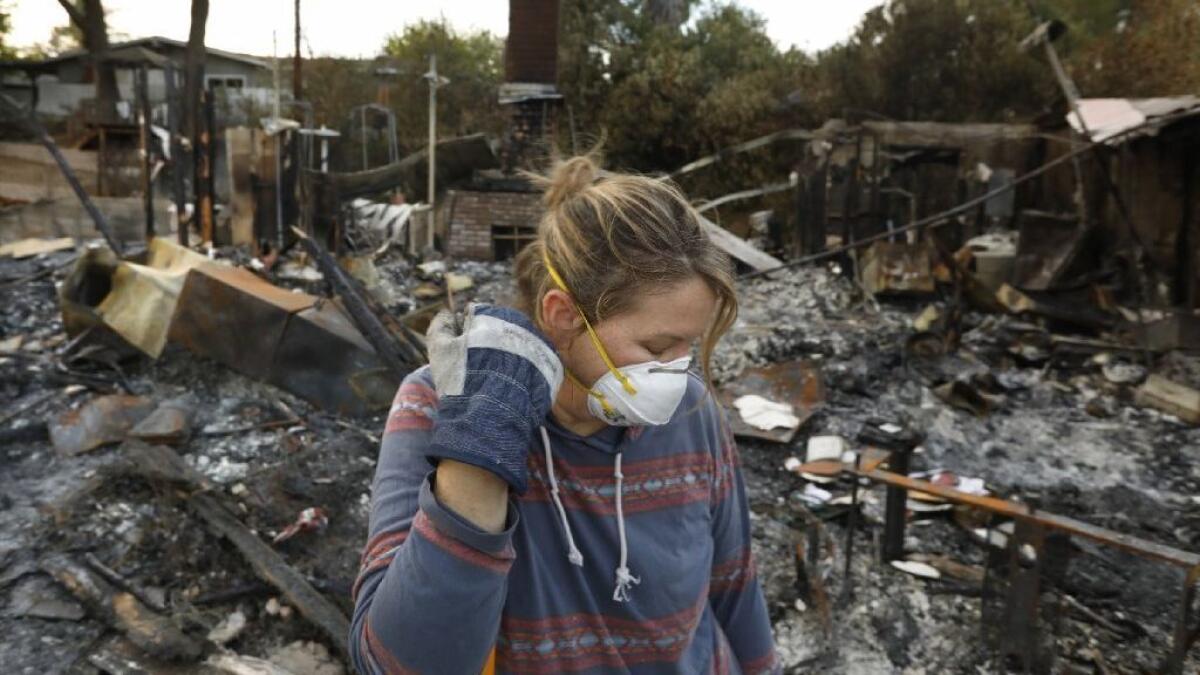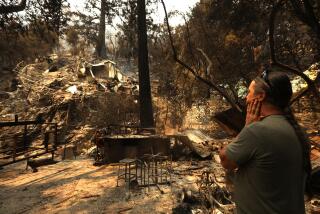Evacuees of Woolsey fire still struggling over how to rebuild their lives

From the ashes of his Malibu home, Wolter Mehring salvaged a coin collection that still gleamed in its blackened box. He and his son had been searching the wreckage with a metal detector on Saturday, looking for jewelry.
Little remained of the house where Mehring and his wife, Patti, had raised their four children. A bit of the brick chimney stood, heaped with a white mess that Mehring said was once an amethyst crystal from Brazil. Their chickens had not survived.
He was still watering an avocado tree that his father-in-law, now deceased, had once planted, hoping it would make it through.
When the Mehrings left, they took little with them. Some passports. A laptop. They had been through fire in Malibu before.
“We always left. We always came back,” Wolter Mehring said. “We didn’t think about not coming back.”
Hundreds of Malibu, Agoura Hills and Thousand Oaks area evacuees spent the holiday weekend returning to their burned-out neighborhoods to survey their damaged or destroyed homes and to begin rebuilding their lives. Some were still debating whether to stay or leave.
The Woolsey fire, which straddled Los Angeles and Ventura counties, began Nov. 8 and killed three people, scorched more than 96,000 acres and destroyed 1,600 structures before it was fully contained on Thanksgiving Day.
In Northern California, firefighters Saturday were closing in on full containment of the state’s deadliest blaze on record. The Camp fire, which began Nov. 8 in Butte County, has killed at least 84 people, destroyed 14,000 homes and blackened more than 153,000 acres. Containment now stands at 95%.
Rain is expected to move into the Camp fire burn areas beginning Tuesday and continue through the end of the week, according to the National Weather Service. Up to 3 inches could fall in lower elevations. On Wednesday, the same system is expected to deliver a half inch to 2 inches in burn areas in Southern California.
Despite intermittent power outages and loss of cellphone and natural gas service in their neighborhoods, residents in the Woolsey fire zone in Southern California began returning over the last week as evacuation orders were lifted. Some orders remain in place for remote hillside and canyon areas.
And yet Mehring remained upbeat. His son Nathan was getting married in a week to his fiancee, Jackie Brody, who joined them in combing the ruins of the house.
The young couple were living on a sailboat after their tiny house nearby was destroyed. The boat was a bit cramped, but water was nice after the flames, Nathan said. And the disaster had calmed some of the wedding jitters, the couple said.
“No one expects too much from you anymore!” Brody joked.
At one point, the soon-to-be bride and groom had kayaked from Pacific Palisades up to Malibu by night to return to the Mehring house, where they found the family dog, a terrier named Maggie, alive amid the rubble days after the blaze.
They were calling her Miracle Maggie, Wolter Mehring said.
Mehring went back and forth about whether they should rebuild. His 81-year-old mother-in-law was set on staying. He had heard that Malibu would expedite building permits. And although he had lost some faith in local government during the disaster, he truly loved Malibu.
Maybe a concrete building could better withstand fire, he mused. “We’re definitely going to get rid of all the pine trees,” he said. “And the neighbors will hopefully get rid of the eucalyptus. I’m too old for this.”
As they surveyed the charred house, Stefanie Colvig pulled up, offering split pea-and-ham soup. She worked at the same school as Patti. Another friend, Chris Ayotte, had stopped by with cookies.
“It’s a new chapter of our life,” Wolter Mehring said philosophically before he turned back to the debris. “I can’t say it’s boring right now.”
Along Trancas Canyon Road on Saturday, a woman snapped photos of the blackened wreckage of what was once an alcohol and drug treatment center. A wedge of scorched wall stood at a tilt, like a listing ship, peering over the Pacific below. Someone had taped business cards to a wall bordering the site, advertising a restoration business, but it was hard to imagine what could be restored.
The woman, who declined to give her name, said she had been sober nearly seven months. “This place saved my life,” she said.
She stayed in Newbury Park after she was evacuated, and it was the first time she had gotten a moment to see what had become of Creative Care Inc. There were people she had gotten to know there who are now living out of state and wanted photos. “It’s sad,” she said. “But it’s just material.
“I have sobriety. I have life,” she said. “And they’ll rebuild.”
The fire seemed to have hopscotched along Latigo Canyon Road as it snaked through the hillside overlooking the Pacific Ocean.
The charred mess of what once was a house sat next to a wooden swing that still swayed in the breeze, suspended from the sweeping branches of a tree overlooking the austere moonscape.
Down the road, Jeremiah Redclay chatted with neighbors outside a blue-gray stucco house that still stood, its generator rumbling, at the corner of Ocean View Drive. Dogs tussled on the brick driveway. Carol King, who lived there, invited a neighbor in to charge her cellphone and offered up her restroom to another stranger.
It had become a gathering place for residents who stayed through the flames and those who trickled back afterward, a rare spot where cellphones could pick up service.
Redclay and his 19-year-old son, Elijah, had remained in the neighborhood to fend off the flames with garden hoses while his wife, Briana, and their younger kids evacuated. At night, they slept on their driveway to prevent embers from creeping up on them. The sound, he said, was like bones breaking. At one point, his truck was engulfed in flames when he stepped away to extinguish another blaze.
“We didn’t have one firetruck up here the whole time,” Redclay said.
Briana Redclay had driven downhill in a car loaded with kids, belongings and their bulldog Forrest and waited for hours at the grocery store. When she asked a deputy which way to go, he said he didn’t know.
Firefighters who had left the hillside told her it was too dangerous up there. They drove in silence to her sister’s house in Toluca Lake.
Hours passed before they had any hint that Jeremiah and Elijah were OK. It was a text message from a stranger whose number her daughter had gotten, someone else who had remained in the blazing hills.
Days later, she and the kids walked back to join them before the evacuation order had been lifted.
For a while, they couldn’t drink the water, which they heard was contaminated. The roads had been blocked, so they were barred from coming and going freely. Dead rats seemed to be everywhere.
“We couldn’t leave the neighborhood for 12 days,” Jeremiah said.
Word was that school would begin again in early December, but the kids doubted it. Teachers had lost their homes, they had heard.
But in some ways, Jeremiah Redclay said, those days had been “kind of a gift.”
The children were outside, exploring the hillsides, untethered from their iPads. Neighbors they had never met became fast friends. A friend hosted a Thanksgiving dinner, filled with people who had stayed and tried to fight the blaze.
“People always think of Malibu as a place with tons of wealthy people,” said Redclay, an artist who paints egg tempera seascapes. “But the bulk of the people here are ordinary people that are hardworking. ... If you live here, it’s like living in a small town.”
And the fire had not made him hesitant to stay in Malibu. “I love it out here,” he said, gesturing toward the glittering horizon to the west. “You’re out of the city. You have the ocean. You always have that connection. For me, as an artist — this gives me that.”
Carol King had lost a house there before, on the same spot where she now greeted her neighbors. It was 1982 and they had bought the home only a year before. This time, the flames came close — right up to the fence — but King kept them at bay with a garden hose. At one point, she said, firetrucks came up to the road, waited an hour and a half, and then turned back.
“It’s a wonder this wooden deck didn’t burn,” she murmured, looking out over the ravine.
Uphill, the road was still blocked to residents. The water, though drinkable, had the smell of chlorine, Briana Redclay said. But in another small sign of normality, a FedEx truck was making its rounds in the neighborhood.
More to Read
Sign up for Essential California
The most important California stories and recommendations in your inbox every morning.
You may occasionally receive promotional content from the Los Angeles Times.











